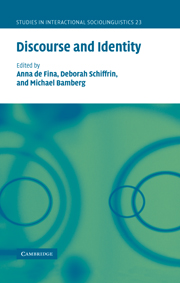Book contents
- Frontmatter
- Contents
- List of contributors
- Introduction
- Part I Overview: theory, method and analysis
- Part II Private and public identities: constructing who we are
- Editors' introduction
- 5 Identity à la carte: you are what you eat
- 6 Workplace narratives, professional identity and relational practice
- 7 Identity and personal/institutional relations: people and tragedy in a health insurance customer service
- 8 The discursive construction of teacher identities in a research interview
- 9 Becoming a mother after DES: intensive mothering in spite of it all
- Part III The gendered self: becoming and being a man
- Part IV The in-between self: negotiating person and place
- References
- index
5 - Identity à la carte: you are what you eat
Published online by Cambridge University Press: 09 November 2009
- Frontmatter
- Contents
- List of contributors
- Introduction
- Part I Overview: theory, method and analysis
- Part II Private and public identities: constructing who we are
- Editors' introduction
- 5 Identity à la carte: you are what you eat
- 6 Workplace narratives, professional identity and relational practice
- 7 Identity and personal/institutional relations: people and tragedy in a health insurance customer service
- 8 The discursive construction of teacher identities in a research interview
- 9 Becoming a mother after DES: intensive mothering in spite of it all
- Part III The gendered self: becoming and being a man
- Part IV The in-between self: negotiating person and place
- References
- index
Summary
Food in history and culture
Once upon a time, not all that long ago, human identity was generally viewed rather simply. It was assumed that identity achieved its final form in the course of childhood and adolescence, culminating in the famous Eriksonian “identity crisis,” the successful resolution of which ushered in a competent adulthood. While experts disputed just when and how the larger aspects of individual identity congealed – gender identity for instance – and argued as well about the relationship between individual and group identity, identity was not seen as something adults actively worked on or typically experienced conflict over.
In recent years, prodded by feminist and queer theorists, students of identity have radically changed their views. Increasingly they see human identity as a continual work in progress, constructed and altered by the totality of life experience. While much of the work in support of this belief concentrates on the larger aspects of identity – especially gender, ethnicity, and sexual preference – in fact human identity involves many other categories. Identity is constructed in complex ways, more or less consciously and overtly. Some aspects of identity, in particular those listed above, are applicable both to individual identity and a person's identification as a member of a cohesive and coherent group.
Other aspects of individual identity are more subtle, perhaps less prone to being problematized, and not linked to group membership in any obvious way.
- Type
- Chapter
- Information
- Discourse and Identity , pp. 142 - 165Publisher: Cambridge University PressPrint publication year: 2006
- 26
- Cited by



